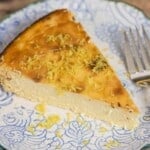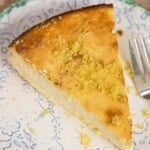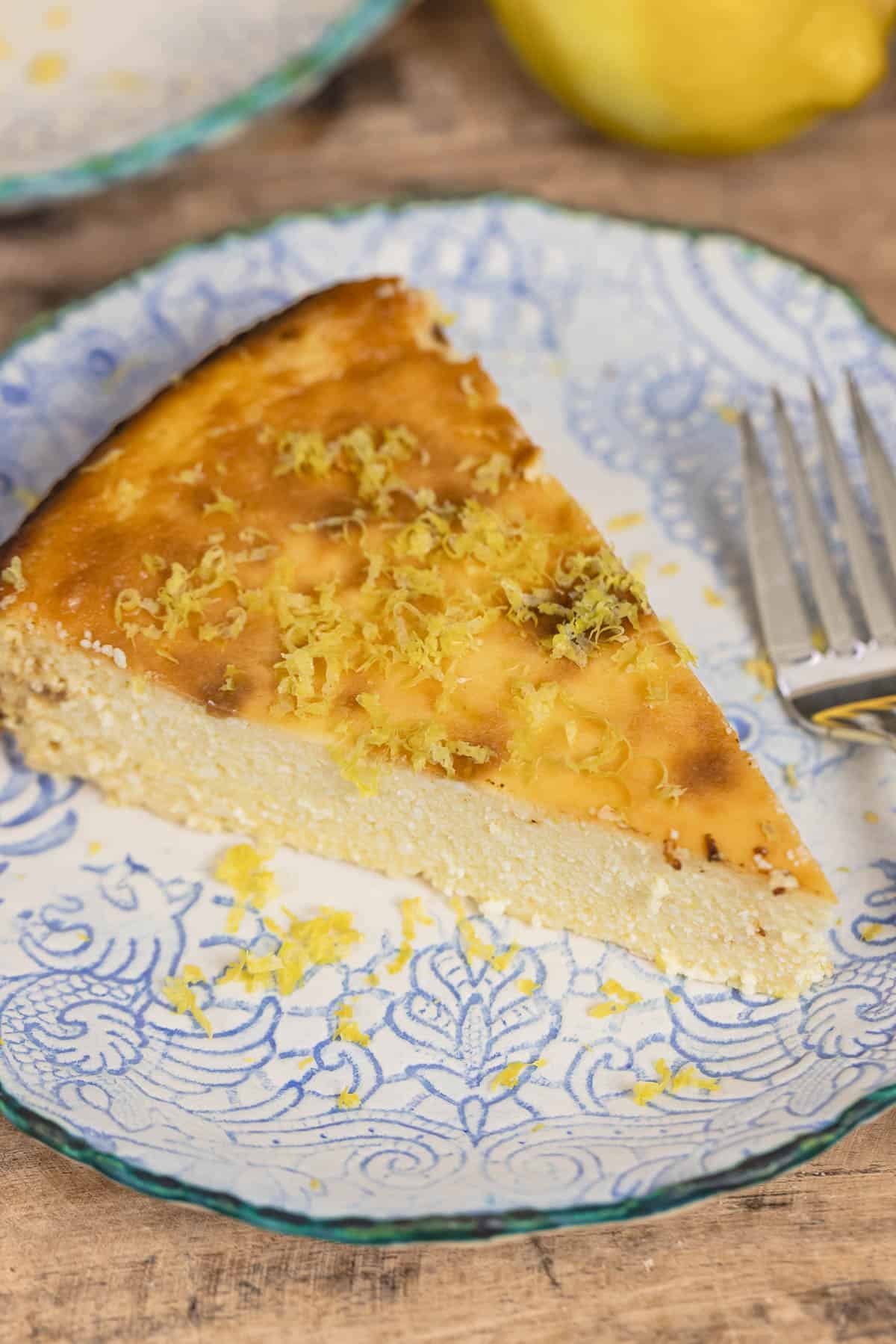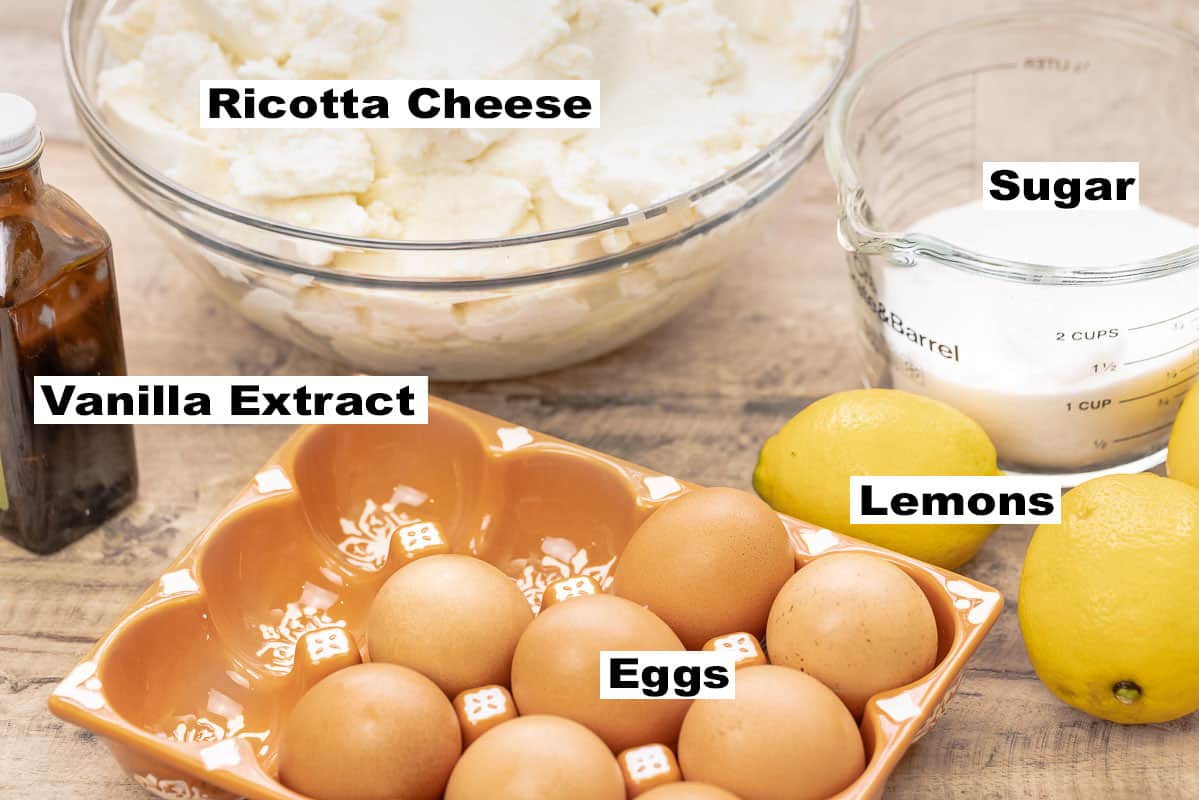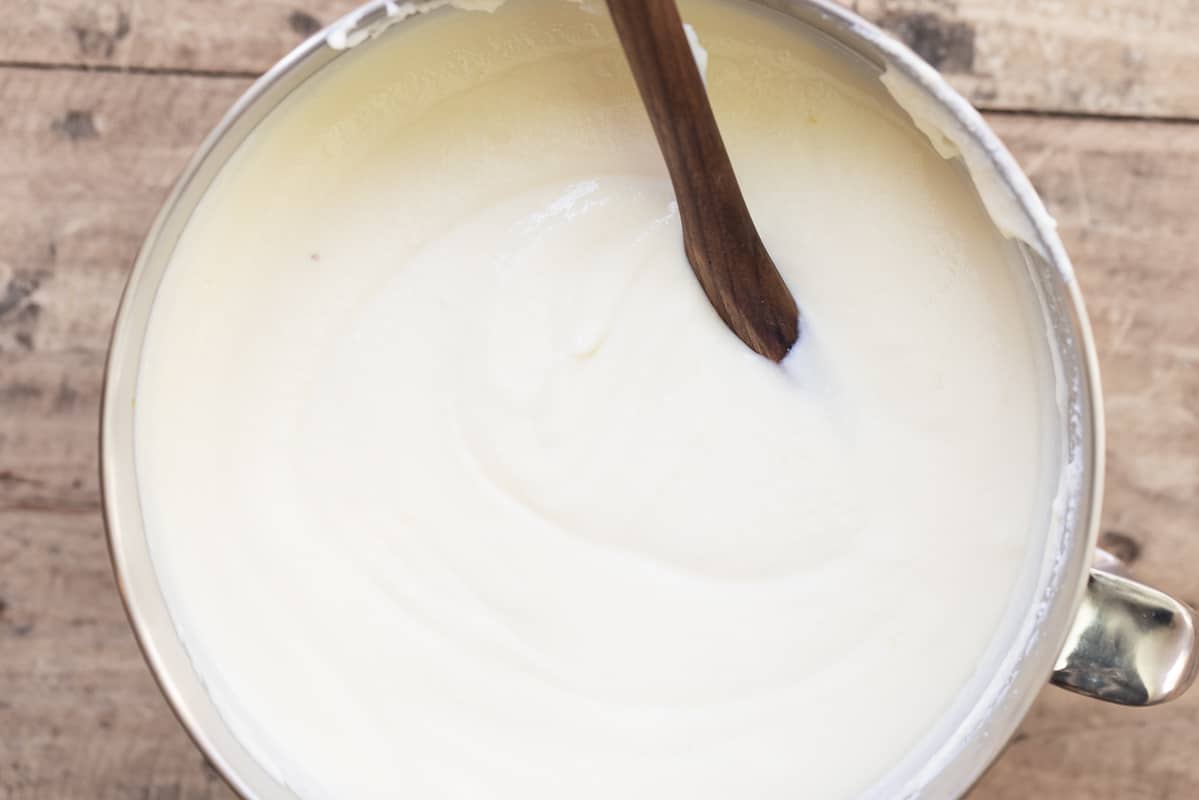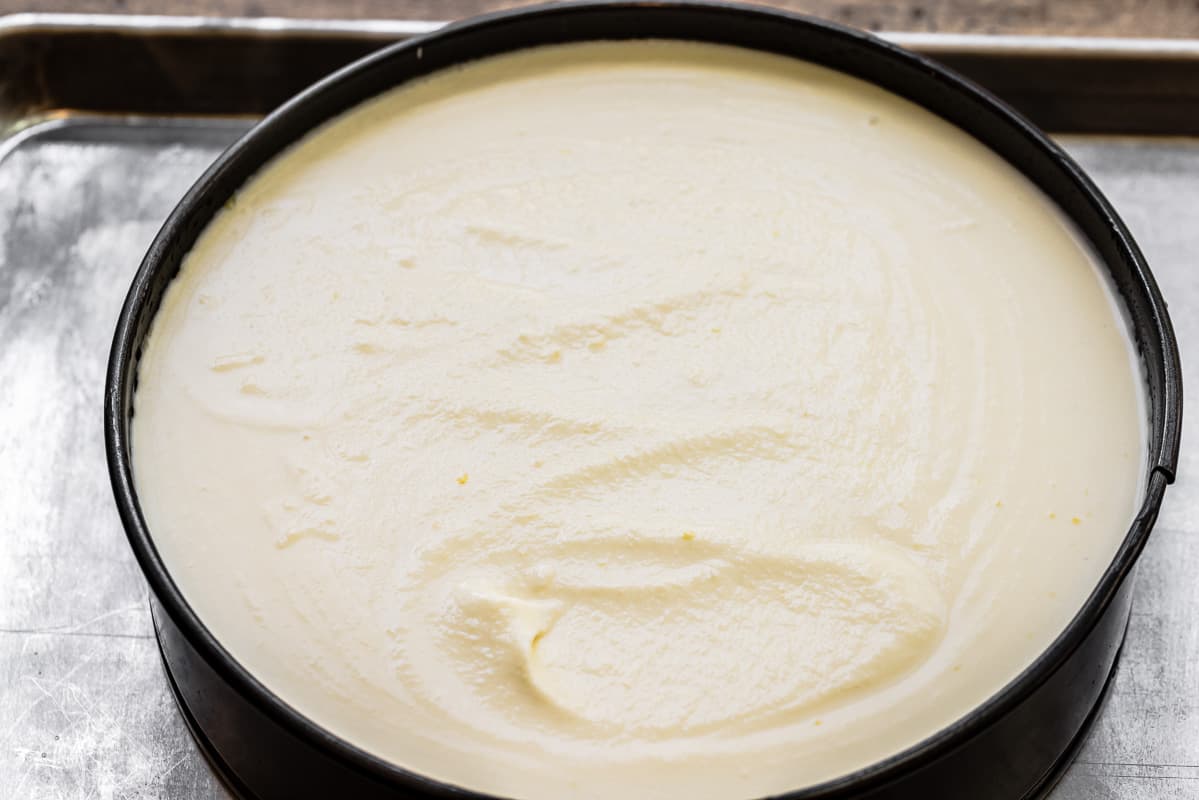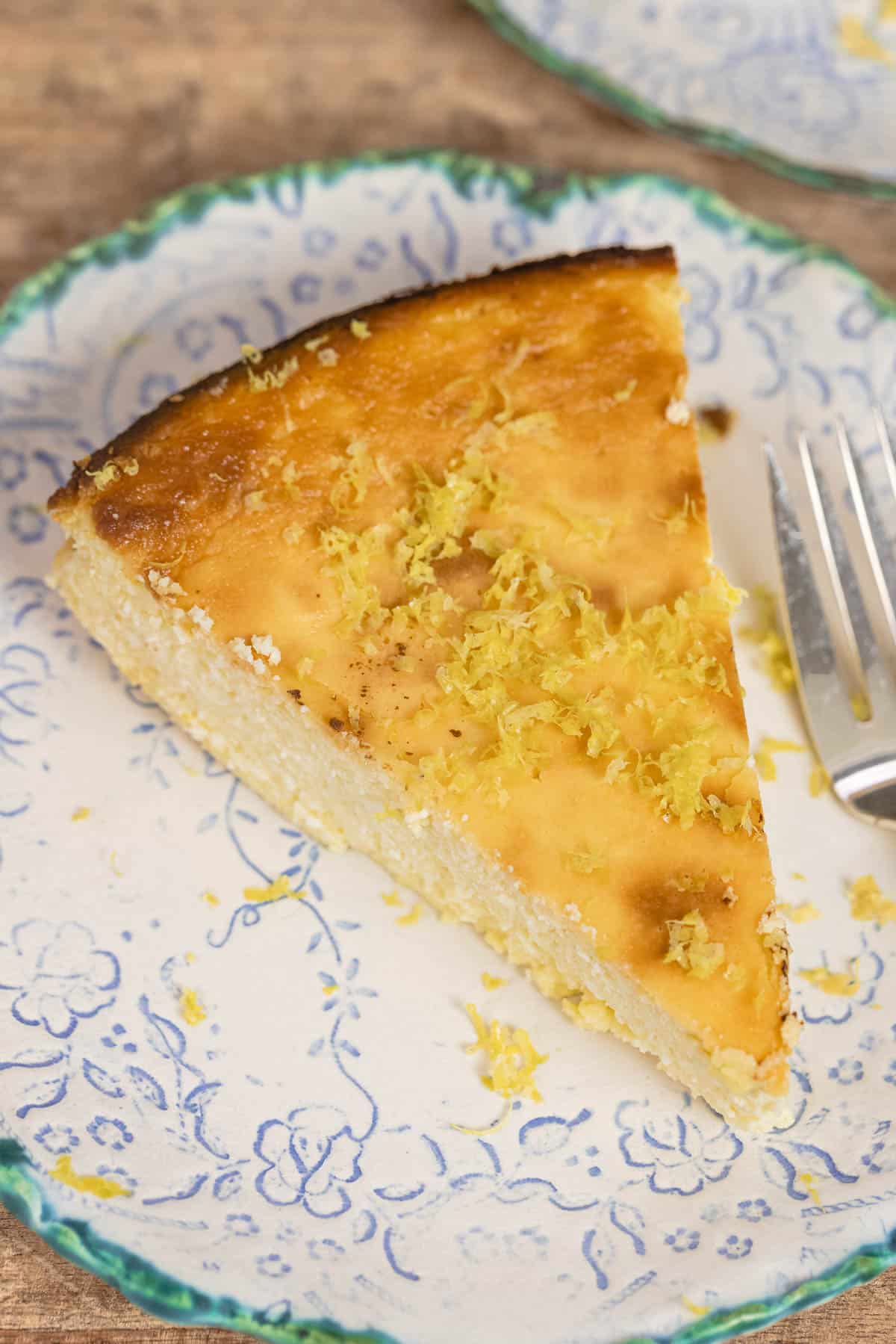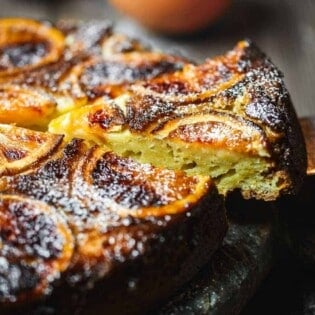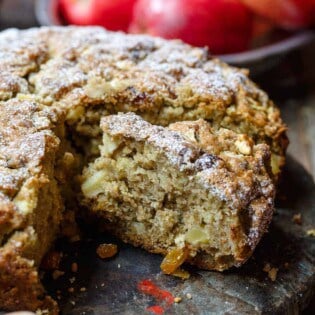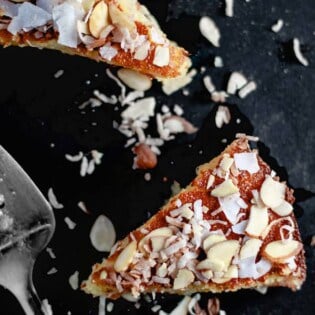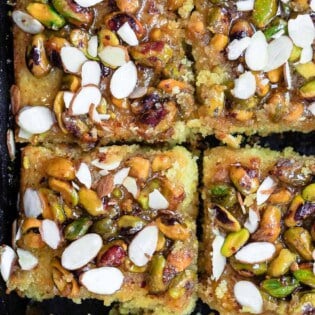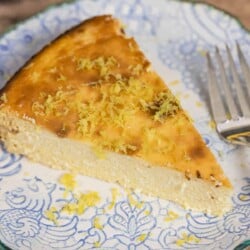Ricotta cheesecake!
This elegant Italian ricotta cheesecake bridges the gap between those who love a full and dense cheesecake, and others like me who prefer a lighter, more airy cheesecake. Plus, it’s the foundation of my amazing Baklava Cheesecake! A must try once you master this recipe. The star ingredient here is none other than whole milk ricotta cheese, which is whipped for a good 10 minutes with eggs and sugar, to create an unbelievably indulgent, yet airy and light batter. Not only does this ricotta cake strike just the right balance in terms of texture and flavor, but it is easy to make with just 5 simple ingredients!And if you thought ricotta should be reserved for savory dishes like eggplant lasagna and baked ziti, this recipe will prove what it can do for your desserts!
How is ricotta cheesecake different from regular cheesecake?
The kind of cheese used makes the biggest difference between Italian ricotta cheesecake and regular cheesecake (or New York-style cheesecake). American cheesecake is made with cream cheese, which is made with milk and cream and will give you a richer, more dense cake. Versus this Italian cheesecake, which uses ricotta cheese, made with milk only and, therefore, will give you a lighter, more airy cake (similar to Italian Cassata Cake, Greek Yogurt Cheesecake, and this Lemon Ricotta Cake). Also, another big difference to note here is that this is a gluten-free crustless cheesecake, which contributes to the cake’s lightness, giving you a daintier finish.
Ingredients and notes for Italian cheesecake with ricotta
You only need 5 ingredients to make this gluten-free ricotta cheesecake recipe:
Whole milk ricotta cheese – You’ll need 3 pounds of ricotta for this recipe. You can use part-skim ricotta, but whole milk ricotta will give you a better result and a melt-in-your-mouth richness. Be sure to select a quality cheese and drain it well before use (more in this later). Eggs – 8 large eggs help to both thicken and smooth the cheesecake batter. You’ll need the egg whites and egg yolks. Sugar – I use white sugar, but you can use a sugar replacement as well. Vanilla extract – Use pure vanilla extract here, not imitation vanilla or vanilla flavor. Lemon zest – You’ll need the zest of 3 lemons to give the ricotta cheesecake the perfect amount of lemony flavor. Olive oil – To coat the springform pan so the cheesecake does not stick. If you must use butter instead, that is fine as well, but be sure to use something to coat the pan.
How to make ricotta cheesecake
With a little advance preparation, you can have a show-stopping ricotta cheesecake for your next dinner party. Here’s how you make it (printer-friendly recipe below):
Strain the ricotta cheese. Place a fine mesh sieve over a bowl. Line the sieve with cheesecloth or two sturdy paper towels. Spoon 3 pounds whole milk ricotta cheese onto the cloth or paper towels, and press firmly with the back of a wooden spoon to release as much liquid as possible into the bowl beneath. Discard the liquid. You can also do this a night ahead and allow the ricotta to drain overnight in the refrigerator. Make the Italian cheesecake batter. Grab the bowl of a large standing mixer (fitted with a blade) and add ricotta cheese, 8 large eggs, 1 ¼ cup sugar, 1 teaspoon vanilla extract, and the zest of 3 lemons. Starting on low and increasing to medium-low (2 on a KitchenAid mixer), mix for 10 minutes. The mixture should look light and fluffy. You can also use a hand-mixer (only use the low speed) or a wooden spoon – both will just take more time. Bake the ricotta cheesecake. Brush the bottom and sides of a 9-inch springform pan with extra virgin olive oil. Don’t skip this step – your cheesecake will stick to the pan if it is not greased. For better control, place the springform pan on a large sheet pan. Pour the ricotta mixture into the baking pan and give it a little shake. Bake on the center rack of a 425 degrees F heated oven for 30 minutes. Then reduce the heat to 375 degrees F and bake for 40 to 45 minutes more. The batter should be mostly firm with a slight jiggle, and the top should have a nice golden brown color. Chill the cheesecake. Remove the crustless cheesecake from the oven and allow it to cool completely. This will take 1 to 2 hours. Then, cover the springform pan with plastic wrap and refrigerate for at least 6 hours. (Note that chilling the cheesecake overnight is best, if you have the time.) Slice and serve. Around 15 minutes before serving, take the cheesecake out of the fridge and remove the springform pan. Slice with a sharp knife and serve by itself, with some sprinkled lemon zest, or a dollop of whipped cream.
Tips for the best ricotta cheesecake
Strain the ricotta cheese very well. Straining the ricotta cheese is important to ensure good texture so that the cheesecake will be creamy and not watery. To do this, place a fine mesh sieve over a bowl and line it with cheesecloth or sturdy paper towels. Spoon the ricotta onto the cheesecloth or paper towels, and press on the cheese with the back of a wooden spoon to coax out as much liquid as possible. If you have time, cover the sieve with plastic wrap and allow the ricotta cheese to strain by itself overnight in the refrigerator. Discard the liquid. Bring cold ingredients to room temperature. Room temperature eggs and ricotta cheese are good for baking because they will blend more evenly in batters resulting in a smoother, creamy consistency. Budget about 30 minutes to 1 hour for the eggs and cheese to sit on the counter till you’re ready to use them. (Cold eggs can result in a lumpy cheesecake batter.) Room temperature ricotta cheese is also good for giving the batter a smooth consistency because it blends easier with the other ingredients when it isn’t cold. Your cheesecake batter will be smooth and creamy. Mix the ricotta cheesecake batter for a full 10 minutes. Whipping the batter continuously on medium-low speed will help incorporate more air into the batter, resulting in a lighter, more airy Italian cheesecake. Use a springform pan and do NOT forget to oil (or butter) the bottom and sides of the pan. Springform pans come in two parts that you can separate, making them really convenient for baked goods that can’t be inverted (like cheesecake!). Just don’t forget to brush the bottom and sides with some olive oil (or butter, if you must) so the cheesecake doesn’t stick to the baking pan. (This is from personal experience! You don’t want the sides of your cake to pull out when you unhook the pan.) Use a thermometer or the wobble test to check whether the baked ricotta cheesecake is done. The internal temperature of a baked cheesecake will be 150 degrees F when it is ready. But if you don’t want to poke holes into the top of your cheesecake, use the wobble test instead. Simply tap the side of the baking pan firmly with a spoon. An undercooked cheesecake will be very jiggly and still slosh around like liquid. A cooked cheesecake will have a slight jiggle, but will be mostly firm. It will also continue to cook a little once you remove it from the oven. Cool completely before serving! Allow the cake to cool completely in the springform pan at room temperature, then stick it in the fridge for at least 6 to 8 hours or overnight. This will allow the cheesecake to fully harden before you begin slicing it, and it will also enhance the flavor.
Cheesecake serving tips
As mentioned earlier, you’ll need to allow the cake to cool completely overnight in the fridge. About 15 minutes before serving, take the cheesecake out of the fridge and remove the springform pan. Slice the no-crust cheesecake with a sharp (not serrated) knife. It helps to keep a pitcher of water nearby to clean the knife and wipe it between slices. You can serve this cake plain with just a sprinkle of lemon zest (or orange zest). You can also add some fresh berries or a sweet-tart berry compote to top your Italian cheesecake for a pop of color.
Can I freeze ricotta cheesecake?
Yes! You can freeze this crustless cheesecake. Leftovers can keep in the fridge, in a tightly closed container, for up to 5 days. But to freeze it, simply wrap the chilled baked cheesecake tightly in plastic wrap and also a layer of foil and freeze for up to 2 months. You can also wrap and freeze individual slices so you only thaw as much as you need at a time. Thaw overnight in the fridge. If thawing out individual slices, they may only need a few hours in the fridge to thaw completely.
More cake recipes
Browse all Mediterranean RecipesVisit Our Shop
Italian-Inspired Orange Ricotta Cake
Italian Apple Olive Oil Cake (w/ Video)
Basbousa: Almond Coconut Semolina Cake Recipe
Greek Honey Cake with Orange and Pistachios

